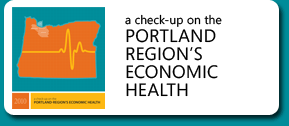Why this Matters to Oregon Families
 Portland-metro* is Oregonís largest community, and its
economic health impacts the economy of the entire state.
Because of its central role, the five organizations sponsoring
this report decided to take a careful look at the health of the
Portland economy in a number of studies to identify the
regionís strengths and weaknesses. This report contains the
findings of the first of those studies.
Portland-metro* is Oregonís largest community, and its
economic health impacts the economy of the entire state.
Because of its central role, the five organizations sponsoring
this report decided to take a careful look at the health of the
Portland economy in a number of studies to identify the
regionís strengths and weaknesses. This report contains the
findings of the first of those studies.
Portland-metro has many economic assets: a strategic location
on the Pacific Rim, a robust transportation system, a relatively
low cost of living and a quality of life that is attractive to
young, well educated individuals. Over the past four decades,
however, Portland-metroís economic performance has not
kept pace with a number of its peers across the nation, and
the differences have become most stark over the last decade.
For example, where we were once virtually an economic twin
to Seattle, our falling incomes now make us more like
Pittsburgh and Cleveland.
The regionís per capita income has declined relative to peer
regions, and private-sector jobs have disappeared in some
areas. These declines impact the financial well-being of the
regionís families. Further, it limits funding for important public
programs like schools and human services. Our quality of life
ultimately depends on our ability to provide public services
funded through taxes on income. If incomes decline and jobs
are lost, quality of life will also decline.
This report is a call to action for all Oregonians. We must
recognize that our valued quality of life will erode if the
regionís economy does not support healthy family incomes,
quality schools and key public services. It is time to make
private sector job creation our immediate and top priority.
It would be tempting to conclude that the concerns identified
in this report are the result of the national financial downturn.
That would be incorrect. In fact, the economic challenges
facing Portland-metro have been building for more than a
decade.
In the 1990s Portland-metro was experiencing significant
economic growth and capital investment. Jobs were growing so
quickly that some local jurisdictions signaled that they couldnít
accommodate more. But in the late-1990s the regionís wages
and income declined relative to peers like Denver, Minneapolis
and Seattle. What happened, and how do we fix it?
Oregon and Portland-metro have shown that we can adopt a
bold, nation-leading vision and then bring it to reality. Weíve
built a world-class public transportation network and created a
visionary land-use system. Now we need to focus that
innovative ability on the economic crisis facing our region and
what is needed to retain the private sector jobs we currently
have and create new jobs through growth of existing firms
and recruitment of new ones.
Through this report, we hope to start a conversation among
public and private leaders to map a course through this crisis.
It will take all of us to create an economically healthy region.
Now is the time to start the work.

Sandra McDonough, President & CEO, Portland Business Alliance

Jay M. Clemens, President & CEO, Associated Oregon Industries

Bill Wyatt, Executive Director, Port of Portland

Ryan Deckert, President, Oregon Business Association

Duncan Wyse, President, Oregon Business Council
Portland-metro, Seattle-metro, Denver-metro and Minneapolis-metro refer to the Metropolitan Statistical Areas of Portland-Vancouver-Hillsboro, OR-WA MSA, Seattle-Bellevue-Everett MSA, Denver-Aurora MSA, and Minneapolis-St. Paul-Bloomington MSA respectively unless otherwise noted. This report looks at a wide array of data to analyze the economic performance of the Portland metropolitan region. Using an array of data gives us the broadest possible base from which to draw conclusions.









 Why this matters
Why this matters